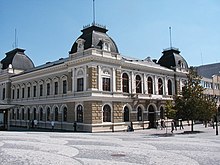Nitra


Nitra (Hungarian: Nyitra / Nyitria [archaic]; German: Neutra ()) is a city in western Slovakia (and the fifth largest urban settlement in Slovakia) situated at the foot of Zobor Mountain in the Nitra River valley. It is the seat of a region (kraj).
Nitra is one of the oldest cities in Slovakia. It existed as a town since at least the early 9th century.
History
Nitra is a city of extraordinary historic importance. Inhabited since time immemorial, it was an important center of the Celts (last centuries B.C.), and later the seat of the first known rulers of what is today Slovak territory, i.e. of :
- the Germanic Quadi around 396? (disputed)
- the Slavic/Slovak Principality of Nitra:
- an independent state (late 8th century - 833)
- Principality of Nitra as part of Great Moravia (833 - ?907)
- Principality of Nitra under Hungarian rule (?925/970 - 1107) [between 1000 and 1030 temporarily under Polish rule ]
Nitra is the site of the first known Christian church in central and eastern Europe, which was built in 828 during the time of the Nitrian Principality, and of the first known bishopric in present-day Slovakia (established 880). In the early Middle Ages, the city reached its height during the reign of prince Svätopluk, who was the prince of Nitra from the 850s to 871 and then the king of Great Moravia till 894. Svätopluk had the first monastery in Slovakia built on the Zobor Mountain during 880-881. During his rule, Nitra consisted of five large, fortified settlements and twenty markets, making it a metropolis of the country. Several churches including at Nitra Castle, Párovce, Nitrianska Blatnica, Lupka, Zobor, and Kostoľany pod Tríbečom existed in and around today's Nitra during the 9th and 10th centuries. Located beyond the city limits are the Great Moravian settlements of Chrenova, Lupka, Branč, Vrable, and Zlaté Moravce. St. Methodius and St. Cyril, creators of the Glagolitic alphabet, an early precursor of the modern Cyrillic alphabet, participated actively in the formation of the Church and the first bishopric in Slovakia, in Nitra. Today, a basilica discovered beneath the Nitra Castle is believed to have been the first Christian church of western and eastern Slavs.
Landmarks
Notable religious structures located in Nitra are the St. Emmeram Cathedral, a Piarist church, a Roman Catholic religious congregation founded by Saint Joseph of Calasanza and a monastery founded in 1701. The monastery church was completed in 1716, but was later destroyed by a fire and remodeled from 1742-1748 in baroque style. Two towers were also added onto the church. The interior was renovated in 1940 and three modern frescos depicting themes from Slovak history of Nitra were created.
The old town (Staré Mesto) is dominated by a castle (Hrad), which is one of the most interesting ancient complexes of buildings in Slovakia. Archeological findings in the past decades indicate that a large fortified castle had already stood here at the time of Samo's Empire, in the seventh century. Recent archeological findings prove the existence of a church from the ninth century beneath the younger, Gothic St. Emmeram Cathedral. The construction of the stone castle began during the 9th century during the reign of the Prince of Nitra Svätopluk. The castle currently serves as the seat of one of Roman-Catholic bishoprics in Slovakia, which was founded in 880 as the first bishopric of western and eastern Slavs, ceased to exist in the 10th century and was refounded around 1110.
The most powerful medium wave transmitter of Slovakia, running on 1098 kHz, was situated in Nitra at Velke Kostolany until recently. This transmitter could broadcast throughout all of Europe at night. Since 2003, however, it has operated on lower output to save energy cost, and has transmitted regional programming only.
Famous People
- Béla I of Hungary (?-1063), Duke of Nitra, King of Hungary
- Saint Bystrík (?-1046), Bishop of Nitra
- Vilmos Fraknói (1843-1924), Hungarian historian
- Koceľ, Prince of the Balaton Principality
- Juraj Kolník (1980-), ice hockey player
- Anton Lehmden (1929-), painter, draughtsman, and printmaker
- Branislav Mezei (1980-), ice hockey player
- Ľubomír Moravčík (1965-), football player
- Zita Pleštinská (1961-), member of the European Parliament
- Pribina (?-861), Prince of the Nitra and Balaton principalities
- Štefan Ružička(1985-), ice hockey player
- Jozef Stümpel (1972-), ice hockey player
- Svatopluk I (830 - 894), Prince of Nitra, King of Great Moravia
- Svatopluk II, Prince of Nitra
Images
-
Nitra Castle, first written reference of the castle dates back to 828.
-
Pribina Statue at Pribina's Square
-
Pribina's Square
-
The Grand Seminary at Pribina's Square
-
Proglas at Nitra Castle (the oldest Slovak and Slavic poem, written during 863-867)
-
The statue of Sts. Cyril and Methodius at the feat of the Nitra Castle
-
Svätopluk's Square and the Nitra Museum with a large exhibition of Great Moravia
-
Virgin Mary´s Assumption Church at Calvary
-
Nitra's Coat of Arms dating back to 1248
-
Nitra, milá Nitra - sword fighting
-
Nitra, milá Nitra - coronation of Svätopluk as Prince of Nitra
-
Nitra, milá Nitra - Prince Rastislav invites Constantine and Methodius to Nitra.
-
Nitra, milá Nitra - King Svätopluk with Wiching, the bishop of Nitra

